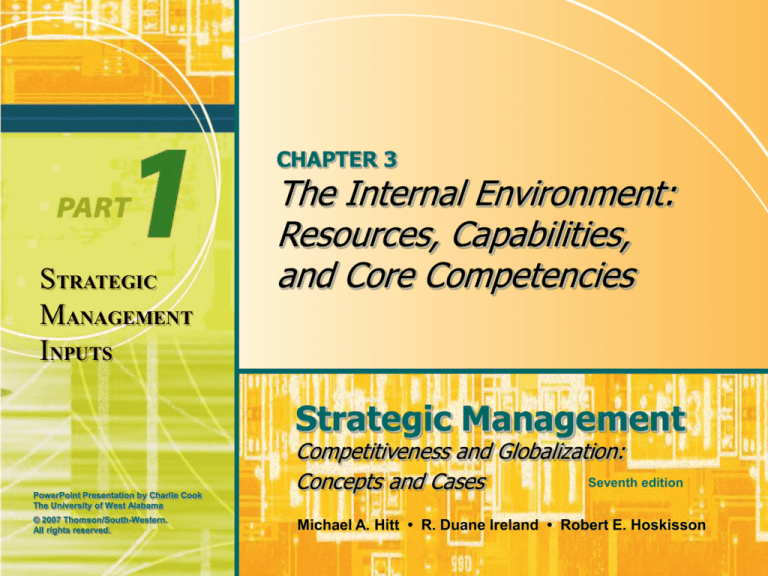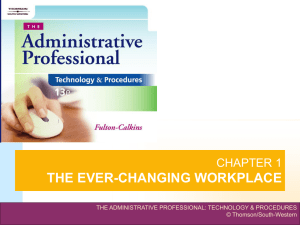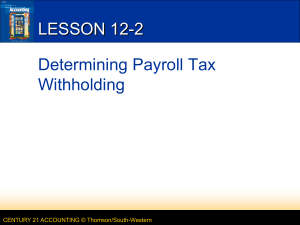
CHAPTER 3
STRATEGIC
MANAGEMENT
INPUTS
The Internal Environment:
Resources, Capabilities,
and Core Competencies
Strategic Management
PowerPoint Presentation by Charlie Cook
The University of West Alabama
© 2007 Thomson/South-Western.
All rights reserved.
Competitiveness and Globalization:
Seventh edition
Concepts and Cases
Michael A. Hitt • R. Duane Ireland • Robert E. Hoskisson
Competitive Advantage
• Firms achieve strategic competitiveness and
earn above-average returns when their core
competencies are effectively:
Acquired.
Bundled.
Leveraged.
• Over time, the benefits of any value-creating
strategy can be duplicated by competitors.
© 2007 Thomson/South-Western. All rights reserved.
3–2
Competitive Advantage (cont’d)
• Sustainability of a competitive advantage is a
function of:
The rate of core competence obsolescence due to
environmental changes.
The availability of substitutes for the core
competence.
The difficulty competitors have in duplicating or
imitating the core competence.
© 2007 Thomson/South-Western. All rights reserved.
3–3
External Analyses’ Outcomes
Opportunities
and threats
By studying the external environment, firms
identify what they might choose to do.
© 2007 Thomson/South-Western. All rights reserved.
3–4
Internal Analyses’ Outcomes
Unique resources,
capabilities, and
competencies
(required for sustainable
competitive advantage)
By studying the internal environment,
firms identify what they can do
© 2007 Thomson/South-Western. All rights reserved.
3–5
The Context of Internal Analysis
• Global Economy
Traditional sources of advantages can be overcome
by competitors’ international strategies and by the
flow of resources throughout the global economy.
• Global Mind-Set
The ability to study an internal environment in ways
that are not dependent on the assumptions of a single
country, culture, or context.
• Analysis Outcome
Understanding how to leverage the firm’s bundle of
heterogeneous resources and capabilities.
© 2007 Thomson/South-Western. All rights reserved.
3–6
FIGURE 3.1
Components of Internal Analysis Leading to
Competitive Advantage and Strategic Competitiveness
© 2007 Thomson/South-Western. All rights reserved.
3–7
Creating Value
• By exploiting their core competencies or
competitive advantages, firms create value.
• Value is measured by:
Product performance characteristics
Product attributes for which customers are willing to
pay
• Firms create value by innovatively bundling and
leveraging their resources and capabilities.
• Superior value Above-average returns
© 2007 Thomson/South-Western. All rights reserved.
3–8
Creating Competitive Advantage
• Core competencies, in combination with productmarket positions, are the firm’s most important
sources of competitive advantage.
• Core competencies of a firm, in addition to its
analysis of its general, industry, and competitor
environments, should drive its selection of
strategies.
© 2007 Thomson/South-Western. All rights reserved.
3–9
The Challenge of Internal Analysis
• Strategic decisions in terms of the firm’s
resources, capabilities, and core competencies:
Are non-routine.
Have ethical implications.
Significantly influence the firm’s ability to earn aboveaverage returns.
© 2007 Thomson/South-Western. All rights reserved.
3–10
The Challenge of Internal Analysis (cont’d)
• To develop and use core competencies,
managers must have:
Courage
Self-confidence
Integrity
The capacity to deal with uncertainty and complexity
A willingness to hold people (and themselves)
accountable for their work
© 2007 Thomson/South-Western. All rights reserved.
3–11
FIGURE
3.2
Conditions Affecting Managerial Decisions about
Resources, Capabilities, and Core Competencies
Source: Adapted from R. Amit & P. J. H. Schoemaker, 1993, Strategic
assets and organizational rent, Strategic Management Journal, 14: 33.
© 2007 Thomson/South-Western. All rights reserved.
3–12
Resources, Capabilities and Core Competencies
• Resources
Discovering Core
Competencies
Core
Competencies
Capabilities
Resources
•Tangible
•Intangible
© 2007 Thomson/South-Western. All rights reserved.
Are the source of a firm’s
capabilities.
Are broad in scope.
Cover a spectrum of
individual, social and
organizational
phenomena.
Alone, do not yield a
competitive advantage.
3–13
Resources
• Resources
Are a firm’s assets,
including people and
the value of its brand
name.
Represent inputs into
a firm’s production
process, such as:
•
•
•
•
•
Capital equipment
Skills of employees
Brand names
Financial resources
Talented managers
© 2007 Thomson/South-Western. All rights reserved.
• Types of Resources
Tangible resources
• Financial resources
• Physical resources
• Technological
resources
• Organizational
resources
Intangible resources
• Human resources
• Innovation resources
• Reputation resources
3–14
TABLE
3.1
Tangible Resources
• The firm’s borrowing capacity
• The firm’s ability to generate internal
funds
Organizational Resources • The firm’s formal reporting structure
and its formal planning, controlling, and
coordinating systems
Physical Resources
• Sophistication and location of a firm’s
plant and equipment
• Access to raw materials
Technological Resources • Stock of technology, such as patents,
trademarks, copyrights, and trade
secrets
Financial Resources
Sources: Adapted from J. B. Barney, 1991, Firm resources and sustained competitive advantage, Journal of Management,
17: 101; R. M. Grant, 1991, Contemporary Strategy Analysis, Cambridge, U.K.: Blackwell Business, 100–102.
© 2007 Thomson/South-Western. All rights reserved.
3–15
TABLE
3.2
Intangible Resources
Human Resources
Innovation Resources
Reputational Resources
•
•
•
•
•
•
•
•
•
•
Knowledge
Trust
Managerial capabilities
Organizational routines
Ideas
Scientific capabilities
Capacity to innovate
Reputation with customers
Brand name
Perceptions of product quality, durability,
and reliability
• Reputation with suppliers
• For efficient, effective, supportive, and
mutually beneficial interactions and
relationships
Sources: Adapted from R. Hall, 1992, The strategic analysis of intangible resources, Strategic Management Journal,
13: 136–139; R. M. Grant, 1991, Contemporary Strategy Analysis, Cambridge, U.K.: Blackwell Business, 101–104.
© 2007 Thomson/South-Western. All rights reserved.
3–16
Resources, Capabilities and Core Competencies
• Capabilities
Discovering Core
Competencies
Represent the capacity to deploy
resources that have been
purposely integrated to achieve a
desired end state
Core
Competencies
Emerge over time through complex
interactions among tangible and
intangible resources
Capabilities
Often are based on developing,
carrying and exchanging
information and knowledge through
the firm’s human capital
Resources
•Tangible
•Intangible
© 2007 Thomson/South-Western. All rights reserved.
3–17
Resources, Capabilities and Core Competencies
• Capabilities (cont’d)
Discovering Core
Competencies
Core
Competencies
Capabilities
Resources
•Tangible
•Intangible
© 2007 Thomson/South-Western. All rights reserved.
The foundation of many
capabilities lies in:
• The unique skills and
knowledge of a firm’s
employees
• The functional expertise of
those employees
Capabilities are often
developed in specific
functional areas or as part
of a functional area.
3–18
TABLE 3.3
Examples of Firms’ Capabilities
Functional Areas
Distribution
Human resources
Management
information systems
Marketing
Management
Manufacturing
Research &
development
Capabilities
Effective use of logistics management techniques
Motivating, empowering, and retaining employees
Effective and efficient control of inventories through
point-of-purchase data collection methods
Effective promotion of brand-name products
Effective customer service
Innovative merchandising
Ability to envision the future of clothing
Effective organizational structure
Design and production skills yielding reliable products
Product and design quality
Miniaturization of components and products
Innovative technology
Development of sophisticated elevator control solutions
Rapid transformation of technology into new products and
processes
Digital technology
© 2007 Thomson/South-Western. All rights reserved.
3–19
Resources, Capabilities and Core Competencies
Discovering Core
Competencies
• Four criteria for
determining strategic
capabilities:
Value
Core
Competencies
Rarity
Costly-to-imitate
Capabilities
Nonsubstitutability
Resources
•Tangible
•Intangible
© 2007 Thomson/South-Western. All rights reserved.
3–20
Resources, Capabilities and Core Competencies
• Core Competencies
Discovering Core
Competencies
Core
Competencies
Capabilities
Resources
•Tangible
•Intangible
© 2007 Thomson/South-Western. All rights reserved.
Resources and capabilities that
are the sources of a firm’s
competitive advantage:
• Distinguish a company
competitively and reflect its
personality.
• Emerge over time through an
organizational process of
accumulating and learning
how to deploy different
resources and capabilities.
3–21
Resources, Capabilities and Core Competencies
• Core Competencies
Discovering Core
Competencies
Core
Competencies
Capabilities
Activities that a firm performs
especially well compared to
competitors.
Activities through which the firm
adds unique value to its goods
or services over a long period of
time.
Resources
•Tangible
•Intangible
© 2007 Thomson/South-Western. All rights reserved.
3–22
Building Core Competencies
Discovering Core
Competencies
• Four Criteria of
Sustainable Competitive
Advantage
Valuable capabilities
Four Criteria of
Sustainable
Advantages
Rare capabilities
Costly to imitate
Nonsubstituable
•
•
•
•
Valuable
Rare
Costly to imitate
Nonsubstitutable
© 2007 Thomson/South-Western. All rights reserved.
3–23
TABLE 3.4
The Four Criteria of Sustainable Competitive Advantage
Valuable Capabilities
• Help a firm neutralize threats or
exploit opportunities
Rare Capabilities
• Are not possessed by many others
Costly-to-Imitate Capabilities
• Historical: A unique and a valuable
organizational culture or brand
name
• Ambiguous cause: The causes and
uses of a competence are unclear
• Social complexity: Interpersonal
relationships, trust, and friendship
among managers, suppliers, and
customers
Nonsubstitutable Capabilities • No strategic equivalent
© 2007 Thomson/South-Western. All rights reserved.
3–24
Building Sustainable Competitive Advantage
• Valuable capabilities
Discovering Core
Competencies
Four Criteria of
Sustainable
Advantages
•
•
•
•
Help a firm neutralize
threats or exploit
opportunities.
• Rare capabilities
Are not possessed by
many others.
Valuable
Rare
Costly to imitate
Nonsubstitutable
© 2007 Thomson/South-Western. All rights reserved.
3–25
Building Sustainable Competitive Advantage
Discovering Core
Competencies
Four Criteria of
Sustainable
Advantages
• Costly-to-Imitate Capabilities
Historical
• A unique and a valuable
organizational culture or brand
name
Ambiguous cause
• The causes and uses of a
competence are unclear
Social complexity
•
•
•
•
Valuable
Rare
Costly to Imitate
Nonsubstitutable
© 2007 Thomson/South-Western. All rights reserved.
• Interpersonal relationships,
trust, and friendship among
managers, suppliers, and
customers
3–26
Building Sustainable Competitive Advantage
Discovering Core
Competencies
• Nonsubstitutable
Capabilities
No strategic equivalent
• Firm-specific knowledge
Four Criteria of
Sustainable
Advantages
•
•
•
•
• Organizational culture
• Superior execution of the
chosen business model
Valuable
Rare
Costly to imitate
Nonsubstitutable
© 2007 Thomson/South-Western. All rights reserved.
3–27
Outcomes from Combinations
of the Four Criteria
Competitive
Consequences
No
No
No
No
Yes
No
No
Yes
Yes
Yes
Yes
Performance
Implications
Competitive
Disadvantage
Below Average
Returns
Yes/
No
Competitive
Parity
Average Returns
No
Yes/
No
Temporary Competitive Advantage
Above Average to
Average Returns
Yes
Yes
Sustainable Competitive Advantage
Above Average
Returns
© 2007 Thomson/South-Western. All rights reserved.
3–28
Table
3.5
Outcomes from Combinations of the Criteria for
Sustainable Competitive Advantage
© 2007 Thomson/South-Western. All rights reserved.
3–29
Value Chain Analysis
• Allows the firm to understand the parts of its
operations that create value and those that do
not.
• A template that firms use to:
Understand their cost position.
Identify multiple means that might be used to facilitate
implementation of a chosen business-level strategy.
© 2007 Thomson/South-Western. All rights reserved.
3–30
Value Chain Analysis (cont’d)
• Primary activities involved with:
A product’s physical creation
A product’s sale and distribution to buyers
The product’s service after the sale
• Support Activities
Provide the assistance necessary for the primary
activities to take place.
© 2007 Thomson/South-Western. All rights reserved.
3–31
Value Chain Analysis (cont’d)
• Value Chain
Shows how a product moves from the raw-material
stage to the final customer.
• To be a source of competitive advantage, a
resource or capability must allow the firm:
To perform an activity in a manner that is superior to
the way competitors perform it, or
To perform a value-creating activity that competitors
cannot complete
© 2007 Thomson/South-Western. All rights reserved.
3–32
FIGURE
3.3
The Basic Value
Chain
© 2007 Thomson/South-Western. All rights reserved.
3–33
Table 3.6
Examining the Value-Creating Potential of Primary Activities
Inbound Logistics
Activities, such as materials handling, warehousing, and inventory control, used to receive, store, and
disseminate inputs to a product.
Operations
Activities necessary to convert the inputs provided by inbound logistics into final product form.
Machining, packaging, assembly, and equipment maintenance are examples of operations activities.
Outbound Logistics
Activities involved with collecting, storing, and physically distributing the final product to customers.
Examples of these activities include finished goods warehousing, materials handling, and order
processing.
Marketing and Sales
Activities completed to provide means through which customers can purchase products and to induce
them to do so. To effectively market and sell products, firms develop advertising and promotional
campaigns, select appropriate distribution channels, and select, develop, and support their sales force.
Service
Activities designed to enhance or maintain a product’s value. Firms engage in a range of servicerelated activities, including installation, repair, training, and adjustment.
Each activity should be examined relative to competitors’ abilities. Accordingly, firms rate each
activity as superior, equivalent, or inferior.
Source: Adapted with the permission of The Free Press, an imprint of Simon & Schuster Adult Publishing Group, from Competitive
Advantage: Creating and Sustaining Superior Performance, by Michael E. Porter, pp. 39–40, Copyright © 1985, 1998 by Michael E. Porter.
© 2007 Thomson/South-Western. All rights reserved.
3–34
Table 3.7
Examining the Value-Creating Potential of Support Activities
Procurement
Activities completed to purchase the inputs needed to produce a firm’s products. Purchased inputs include
items fully consumed during the manufacture of products (e.g., raw materials and supplies, as well as fixed
assets—machinery, laboratory equipment, office equipment, and buildings).
Technological Development
Activities completed to improve a firm’s product and the processes used to manufacture it. Technological
development takes many forms, such as process equipment, basic research and product design, and
servicing procedures.
Human Resource Management
Activities involved with recruiting, hiring, training, developing, and compensating all personnel.
Firm Infrastructure
Firm infrastructure includes activities such as general management, planning, finance, accounting, legal
support, and governmental relations that are required to support the work of the entire value chain.
Through its infrastructure, the firm strives to effectively and consistently identify external opportunities and
threats, identify resources and capabilities, and support core competencies.
Each activity should be examined relative to competitors’ abilities. Accordingly, firms rate each
activity as superior, equivalent, or inferior.
Source: Adapted with the permission of The Free Press, an imprint of Simon & Schuster Adult Publishing Group, from Competitive
Advantage: Creating and Sustaining Superior Performance, by Michael E. Porter, pp. 40–43, Copyright © 1985, 1998 by Michael E. Porter.
© 2007 Thomson/South-Western. All rights reserved.
3–35
The Value-Creating Potential of Primary
Activities
• Inbound Logistics
Activities used to receive, store, and disseminate
inputs to a product
• Operations
Activities necessary to convert the inputs provided by
inbound logistics into final product form
• Outbound Logistics
Activities involved with collecting, storing, and
physically distributing the product to customers
© 2007 Thomson/South-Western. All rights reserved.
3–36
The Value-Creating Potential of Primary
Activities (cont’d)
• Marketing and Sales
Activities completed to provide the means through
which customers can purchase products and to
induce them to do so.
• Service
Activities designed to enhance or maintain a product’s
value
• Each activity should be examined relative to competitor’s
abilities and rated as superior, equivalent or inferior.
© 2007 Thomson/South-Western. All rights reserved.
3–37
The Value-Creating Potential of Primary
Activities: Support
• Procurement
Activities completed to purchase the inputs needed to
produce a firm’s products.
• Technological Development
Activities completed to improve a firm’s product and
the processes used to manufacture it.
• Human Resource Management
Activities involved with recruiting, hiring, training,
developing, and compensating all personnel.
© 2007 Thomson/South-Western. All rights reserved.
3–38
The Value-Creating Potential of Primary
Activities: Support (cont’d)
• Firm Infrastructure
Activities that support the work of the entire value
chain (general management, planning, finance,
accounting, legal, government relations, etc.)
• Effectively and consistently identify external
opportunities and threats
• Identify resources and capabilities
• Support core competencies
Each activity should be examined relative to
competitor’s abilities and rated as superior, equivalent
or inferior.
© 2007 Thomson/South-Western. All rights reserved.
3–39
Figure
3.4
Prominent
Applications of
the Internet in
the Value Chain
Source: Reprinted by permission
of Harvard Business Review from
“Strategy and the Internet” by
Michael E. Porter, March 2001,
p. 75. Copyright © 2001 by the
Harvard Business School
Publishing Corporation; all rights
reserved.
© 2007 Thomson/South-Western. All rights reserved.
3–40
Outsourcing
• The purchase of a value-creating activity from an
external supplier
Few organizations possess the resources and
capabilities required to achieve competitive
superiority in all primary and support activities.
• By performing fewer capabilities:
A firm can concentrate on those areas in which it can
create value.
Specialty suppliers can perform outsourced
capabilities more efficiently.
© 2007 Thomson/South-Western. All rights reserved.
3–41
Outsourcing Decisions
Service
Marketing and Sales
Procurement
Technological Development
Human Resource Mgmt.
Firm Infrastructure
Support Activities
A firm may outsource
all or only part of one
or more primary and/or
support activities.
Outbound Logistics
Operations
Inbound Logistics
Primary Activities
© 2007 Thomson/South-Western. All rights reserved.
3–42
Strategic Rationales for Outsourcing
• Improving business focus
Helps a company focus on broader business issues
by having outside experts handle various operational
details.
• Providing access to world-class capabilities
The specialized resources of outsourcing providers
makes world-class capabilities available to firms in a
wide range of applications.
© 2007 Thomson/South-Western. All rights reserved.
3–43
Strategic Rationales for Outsourcing (cont’d)
• Accelerating re-engineering benefits
Achieves re-engineering benefits more quickly by
having outsiders—who have already achieved worldclass standards—take over process.
• Sharing risks
Reduces investment requirements and makes firm
more flexible, dynamic and better able to adapt to
changing opportunities.
• Freeing resources for other purposes
Redirects efforts from non-core activities toward those
that serve customers more effectively.
© 2007 Thomson/South-Western. All rights reserved.
3–44
Outsourcing Issues
• Seeking greatest value
Outsource only to firms possessing a core
competence in terms of performing the primary or
supporting the outsourced activity.
• Evaluating resources and capabilities
Do not outsource activities in which the firm itself
can create and capture value.
• Environmental threats and ongoing tasks
Do not outsource primary and support activities that
are used to neutralize environmental threats or to
complete necessary ongoing organizational tasks.
© 2007 Thomson/South-Western. All rights reserved.
3–45
Outsourcing Issues (cont’d)
• Nonstrategic team resources
Do not outsource capabilities critical to the firm’s
success, even though the capabilities are not actual
sources of competitive advantage.
• Firm’s knowledge base
Do not outsource activities that stimulate the
development of new capabilities and competencies.
© 2007 Thomson/South-Western. All rights reserved.
3–46
Cautions and Reminders
• Never take for granted that core competencies will
continue to provide a source of competitive advantage.
• All core competencies have the potential to become core
rigidities—former core competencies that now generate
inertia and stifle innovation.
• Determining what the firm can do through continuous and
effective analyses of its internal environment will increase
the likelihood of long-term competitive success.
© 2007 Thomson/South-Western. All rights reserved.
3–47
What Are the Firm’s Strengths, Weaknesses,
Opportunities and Threats
•
S W O T represents the first letter in
S trengths
W eaknesses
O pportunities
T hreats
•
S
W
O
T
Strategy-making must be well-matched to both
A firm’s resource strengths and weaknesses
A firm’s best market opportunities and external threats to its
well-being
© 2007 Thomson/South-Western. All rights reserved.
3–48
SWOT ANALYSIS
• STRENGTH – INTERNAL
• WEAKNESS – INTERNAL
• OPPORTUNITIES –EXTERNAL
• THREATS -EXTERNAL
© 2007 Thomson/South-Western. All rights reserved.
3–49
Identifying Resource Strengths
and Competitive Capabilities
•
A strength is something a firm does well or a characteristic
that enhances its competitiveness
Valuable competencies or know-how
Valuable physical assets
Valuable human assets
Valuable organizational assets
Valuable intangible assets
Important competitive capabilities
An attribute that places a company in
a position of market advantage
Alliances or cooperative ventures
© 2007 Thomson/South-Western. All rights reserved.
3–50
Identifying Resource Weaknesses
and Competitive Deficiencies
•
A weakness is something a firm lacks,
does poorly, or a condition placing it at a
disadvantage
•
Resource weaknesses relate to
Deficiencies in know-how or expertise or
competencies
Lack of important physical, organizational, or
intangible assets
Missing capabilities in key areas
© 2007 Thomson/South-Western. All rights reserved.
3–51
Identifying External Threats
•
•
•
•
•
•
•
•
•
Emergence of cheaper/better technologies
Introduction of better products by rivals
Intensifying competitive pressures
Onerous regulations
A rise in interest rates
Potential of a hostile takeover
Unfavorable demographic shifts
Adverse shifts in foreign exchange rates
Political upheaval in a country
© 2007 Thomson/South-Western. All rights reserved.
3–52
Role of SWOT Analysis in
Crafting a Better Strategy
•
Developing a clear understanding of a company’s
•
•
Resource strengths
Resource weaknesses
Best opportunities
External threats
Drawing conclusions
about how best to deploy
resources in light of the company’s internal
and external situation
Thinking strategically about how to strengthen the
company’s resource base for the future
© 2007 Thomson/South-Western. All rights reserved.
3–53
SWOT Analysis -- What to Look For
Potential Resource
Strengths
Potential Resource
Weaknesses
Potential Company
Opportunities
Potential External
Threats
• Powerful strategy
• Strong financial
condition
• Strong brand name
image/reputation
• Widely recognized
market leader
• Proprietary
technology
• Cost advantages
• Strong advertising
• Product innovation
skills
• Good customer
service
• Better product
quality
•Alliances or JVs
• No clear strategic
direction
• Obsolete facilities
• Weak balance
sheet; excess debt
• Higher overall
costs than rivals
• Missing some key
skills/competencies
• Subpar profits . . .
• Internal operating
problems . . .
• Falling behind in
R&D
• Too narrow product
line
• Weak marketing
skills
• Serving additional
customer groups
• Expanding to new
geographic areas
• Expanding product
line
• Transferring skills
to new products
• Vertical integration
• Openings to take
MS from rivals
• Acquisition of
rivals
• Alliances or JVs to
expand coverage
• Openings to exploit
new technologies
• Openings to extend
brand name/image
• Entry of potent new
competitors
• Loss of sales to
substitutes
• Slowing market
growth
• Adverse shifts in
exchange rates &
trade policies
• Costly new
regulations
• Vulnerability to
business cycle
• Growing leverage
of customers or
suppliers
• Shift in buyer
needs for product
• Demographic 3–54
changes
© 2007 Thomson/South-Western. All rights reserved.








